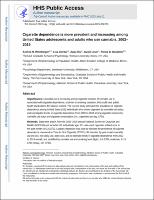Please use this identifier to cite or link to this item:
https://hdl.handle.net/20.500.12202/9419| Title: | Cigarette dependence is more prevalent and increasing among US adolescents and adults who use cannabis, 2002–2019 |
| Authors: | Weinberger, Andrea H Dierker, Lisa Zhu, Jiaqi Levin, Jacob Goodwin, Renee D 0000-0001-5502-1376 |
| Keywords: | co-substance use nicotine cigarettes addiction public policy |
| Issue Date: | 2021 |
| Publisher: | BMJ Publishing Group |
| Citation: | Weinberger, A. H., Dierker, L., Zhu, J., Levin, J., & Goodwin, R. D. (2021). Cigarette dependence is more prevalent and increasing among US adolescents and adults who use cannabis, 2002–2019. Tobacco Control, tobaccocontrol-2021-056723. https://doi.org/10.1136/tobaccocontrol-2021-056723 |
| Series/Report no.: | Tobacco Control; |
| Abstract: | __Significance__ Cannabis use is increasing among cigarette smokers. If cannabis use is associated with cigarette dependence, a barrier to smoking cessation, this could have public health implications for tobacco control. The current study estimated the prevalence of cigarette dependence among US individuals who smoke cigarettes by cannabis use status, and investigated trends in cigarette dependence from 2002 to 2019 among cigarette smokers by cannabis use status and cigarette consumption (ie, cigarettes per day, CPD). __Methods__ Data were drawn from the 2002–2019 annual National Survey on Drug Use and Health and included US individuals aged 12+ years who used cigarettes at least once in the past month (n=231 572). Logistic regression was used to estimate the prevalence of cigarette dependence, measured as time to first cigarette <30 min, by past-month cannabis use (no use, non-daily use, daily use), and to estimate trends in cigarette dependence from 2002 to 2019 overall and stratified by cannabis use and smoking level (light, 1–5 CPD; moderate, 6–15 CPD; heavy, 16+ CPD). __Results__ Across all levels of cigarette use, cigarette dependence was significantly more common among individuals with daily cannabis use compared with those with non-daily or no cannabis use. From 2002 to 2019, cigarette dependence increased among cigarette smokers with non-daily cannabis use, and among light and moderate cigarette smokers with no cannabis use. __Conclusions__ US individuals who use both cigarettes and cannabis report a higher prevalence of cigarette dependence relative to individuals who use cigarettes and do not use cannabis at virtually all levels of cigarette consumption. Further, cigarette dependence is increasing in the USA both among those who use and do not use cannabis. Given the increase in cannabis use among those using cigarettes, efforts to elucidate the nature of the association between cannabis and cigarette dependence are needed. |
| Description: | Scholarly article / Open Access |
| URI: | https://tobaccocontrol.bmj.com/content/32/4/443.info https://hdl.handle.net/20.500.12202/9419 |
| ISSN: | 0964-4563 (Print) 1468-3318 (Electronic) |
| Appears in Collections: | Ferkauf Graduate School of Psychology: Faculty Publications |
Files in This Item:
| File | Description | Size | Format | |
|---|---|---|---|---|
| Weinberg 2021 OA Cigarettes nihms-1757158.pdf | 181.23 kB | Adobe PDF |  View/Open |
This item is licensed under a Creative Commons License

